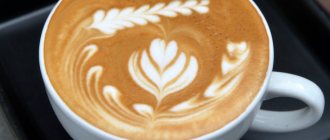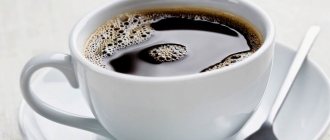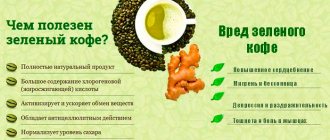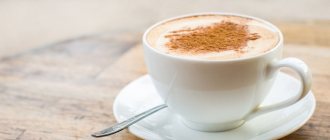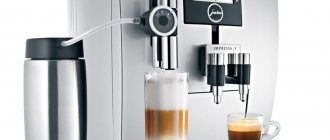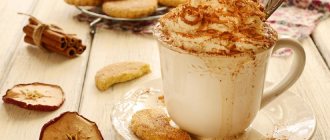The latte coffee drink has won recognition all over the world. It is sometimes confused with whitened coffee. Or rather, not his name, but the name. But there is a strict recipe according to which this cocktail is prepared, with the help of specialists from coffee shops, restaurants, and on coffee machines at home. However, the calorie content of a latte can vary significantly.
The energy value of the drink is directly related to milk:
- its quality;
- fat content;
- additives (sweeteners, syrups, fillers);
- volumes.
In the article we will provide information about calories in lattes and how they are calculated.
Calculating the energy component of a latte
There are no standard volumes for the cocktail. It is prepared for dishes of different sizes. 120-480 ml. For a cappuccino, a dairy product is heated and then turned into foam. In a latte, the milk component is used in the entire serving size, with not very tight, loose foam.
The classic latte variation is espresso with the addition of whipped milk ingredient.
If you are preparing a macchiato, then pour milk into a cup or glass, and then add espresso in a thin stream. The calories remain the same in both the first method and the second.
Calculating the calorie content of a latte
Coffee contains 1 to 2 kcal calories. If large glasses contain a double or triple shot of espresso (60, 90 grams), there will be 2 kcal. This is an insignificant figure if we take a person’s entire daily diet and its energy value.
Institutions and coffee shops are content with a milk component of 2.5% standard, mass fat content.
It produces foam, and its taste is neither watery nor too greasy. And such cocktails contain 52 kcal per 100 ml.
A latte is prepared with a dairy product and the result is:
- 120 ml contains 90 ml of milk, energy value 47 kcal;
- 180 ml -120 ml, 62;
- 240 ml – 180 ml, 94;
- 450 ml – 340 ml, 177.
Coffee establishments prepare cocktails that differ in milk fat content. In homemade cocktails, the caloric content is also different:
- in packaged, 100 grams of skim milk, there are 34 kcal.
- 1.5% - 44 kcal;
- ordinary - 2.5% - 52%;
- purchased in a store - 3.2% - 58;
- fat 3.5% – 61;
- whole – 64;
- soybean 0.1% - 28;
- soy 0.6% -43.
If you want to know how high the calorie content of a latte is, and how many kilocalories you will get by preparing your glass of latte, then divide the number of kcal by 100 and multiply by the volume of glassware used.
Calorie content of different types of coffee
calories in instant coffee without sugar depend on its type, since different varieties and different processing technologies of coffee beans when developing an instant product affect its composition and digestibility. According to the results of testing several brands of instant coffee, the tested samples contain different amounts of kilocalories:
- Milagro Gold contains only 150 kcal per 100 grams of product.
- Dark Card Gold is even the least caloric - 92.4 kcal.
- Jacobs Monarch has 101 kcal.
- Ambassador Coffee has a significantly higher energy value - 329 kilocalories per 100 grams.
- The record holder for the lowest amount of calories is Nescafe Gold. 100 grams of coffee contain only 49 kilocalories.

Coffee sweet drink
With the most delicate foam and creamy taste, this cocktail is simply mesmerizing. And it is impossible to refuse it, especially for the fair sex. Even if you’re on a diet, after it’s over, your favorite morning milk and sweets, albeit not every day, but once a week, are an undoubted attribute of your mood for the whole day. You can count calories and think about compensating for sweetness.
Basically, they use 2.5% milk. If in tsp. up to 8 grams of sugar, that’s up to 30 kcal.
- A glass of 120 ml - 47 kcal, with 1 teaspoon - 77 kcal, with two - 107 kcal.
- 180 ml – 62 kcal, 1 tsp. – 92, with 2 – tsp. – 122 kcal.
- 240 ml – 94, with 1 tsp. 124, with 2 – 154 kcal.
- 450 – 177 – with 1 tsp. – 207, with 2 tsp. – 237 kcal.
Syrups can add 35 – 40 kcal per 10 ml. Then do the math for yourself.
Energy value of additives in coffee
The maximum calories are contained in coffee additives: milk, cream. Therefore, to make drinks, they often use the least calorie skim milk and vegetable cream. The number of calories differs for different additive options (data are given in kilocalories per 100 grams of product):
- cream with 10% fat content contains 119, 20% - 207, 35% - 337 kcal,
- dry cream 42% - 579 kcal,
- milk 3.5% - 62, 3.2% - 60, 2.5% - 54, 1.5% - 45 kcal,
- skim milk or a milk product with low fat content up to 1% supplies the body with 32 to 43 kcal,
- 100 grams of McDonalds watery cream contains 20 kcal,
- vegetable cream 4% includes 89, 29% - 510, 35% - 543 kcal.
Adding cream, milk, syrup, and honey to coffee will significantly increase its energy value. Therefore, for those who like to cheer themselves up with coffee in the morning and at the same time adhere to a serious diet, the best option would be to give up high-calorie additives or stop at dairy and plant-based products with low fat content.
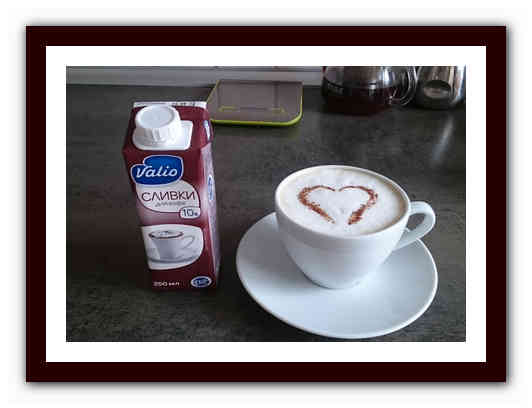
Spices and fruits may be candidates for cream and milk. Many of them perfectly complement and enrich the coffee taste, add special notes to the smell of the drink, and at the same time they contain a minimum of calories. Not enough people will be indifferent to coffee recipes with orange slices, cinnamon, vanilla, cloves, cardamom or star anise.
There are options for the drink with added alcohol, but the main ingredient in such recipes is usually ground natural coffee. In addition, alcohol is a high-calorie product: the energy value of cognac is 239 kcal per 100 grams, for liqueur it is even higher - from 299 to 345 kilocalories, because in addition to alcohol it also contains a huge amount of carbohydrates.
Strong forty-proof rum, often used in recipes for coffee drinks, contains 231 kilocalories per 100 ml.
So, those who like to drink instant coffee without sugar and any additives don’t have to bother themselves with calorie counting. The energy value of this version of the drink is low. The addition of certain additives significantly increases the calorie content of coffee and should be taken into account when following a diet.
Calorie content of bagged latte
This is a sweet dry powder. It contains dry milk extract and flavoring. Some manufacturers add components that look like foam, but of course, this is far from the original. A natural, freshly prepared coffee cocktail cannot be compared in any way.
Packets containing sweeteners, concentrated milk solids and unsaturated flavors. And to increase the sweetness of the drink, sugar is added and the calorie content increases.
It’s easy to calculate how many calories a latte contains in such a serving. The nutritional value will not change whether you drink from a large cup or a small one. As you know, soluble components are not absorbed by the body, but are deposited. And then the figure suffers.
Calories in latte with sugar
Latte is especially loved by ladies for its delicate foam and creamy taste. And representatives of the fair sex love sweets. And although they often go on diets, denying themselves almost everything, a morning cup of their favorite “milk coffee” with sugar is allowed. Just calculate your total calories depending on what sweetener you use, and think about how you can make up for the sweetness.
For the table, let’s take the most ordinary, 2.5% fat milk. A teaspoon contains approximately 6 grams of sugar, which is 20 kcal.
Syrup lovers need to know that most of them contain 35-40 kilocalories per 10 ml! This is a volume of 2 teaspoons, two clicks on the dispenser. For a rich taste, you will have to add all 20 ml to a huge cup, which means another plus 75-80 kcal.
To summarize all of the above
- In medium latte cups, without adding sweeteners, you will get 62 - 94 kcal.
- Energy components depend on the amount of milk product, including its fat content.
- Sweets together with syrups provoke an increase in the value of energy components: 1 tsp. sugar, about 30 kcal. The syrup is about 40 kcal.
- A latte made from coffee aggregates is approximately similar in energy value to a conventionally prepared one. If you are thoroughly concerned with counting calories, then it is better to skip this option.
- Coffee shops offer large portions of lattes with additives. This is approximately 250 -280 kcal, not counting sweeteners.
How many calories are in coffee with milk?
Milk is the most popular additive to coffee. And this product has no small calorie content. So that you can calculate the final values without the help of others, you need to know what content of the necessary substances is in milk. It should not be forgotten that the numbers vary greatly depending on the fat content, and in the process of preparing the drink for sale. Below you will find everything you need.
Calorie content of instant coffee without sugar.
Julia Vern 20 268 0
It is necessary to take into account the energy value of goods for those who are watching their weight, are on a diet for weight loss, or, on the contrary, want to gain a little weight. Therefore, lovers of an invigorating drink are often interested in the calorie content of instant coffee without sugar. The amount of energy absorbed by the body from a particular food product depends on its composition: the amount of proteins, fats, carbohydrates and alcohols.
We offer you a variety of coffees with added milk
There are many of them, choose to your liking:
- Latte coffee has the highest milk content in espresso, ¼ of the volume or two shots per serving of brewed coffee.
- Cappuccino contains equal amounts of milk and espresso.
- Macchiato with a thin layer of milk foam and espresso coffee.
- Latte macchiato – layers of milk and milk foam.
- Mocha - a combination of chocolate, milk, milk foam, espresso.
- Flat white, an Australian drink, contains espresso and a small amount of steamed milk.
- Brauner, the Austrian version, has a lot of milk and a little coffee.
- The French cafe oh-le also has a lot of milk and little coffee.
- Brave milk and cream are added to espresso.
- Honey raffe, honey is added as the first layer, then espresso, and frothed milk completes the composition
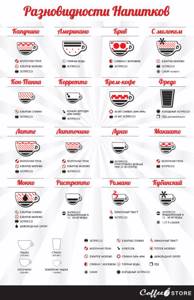
How many calories are in a latte from common brands that sell milkshakes?
- A 480 ml cup of Starbucks caramel contains 250 kcal.
- 480 - Starbucks nut -190.
- 360 - McDonald's - 140.
- 480 - McDonald's - 210.
- 250 - in the classic Coffee House - 111.
- 250 - in low-fat Coffee House -73.
- 360 — vanilla coffee Bean -210.
- 480 - classic Bean coffee -260.
- 330 - in Coffeemania - 156.
- 450 - in Coffeemania - 218.
- 400 - in Shokoladnitsa - 220.
- 320 - in Shokoladnitsa light -125.
If life without coffee is not sweet, and you want to eliminate the calories you consume, then reduce the amount of sugar and additives. Of course, you can only use the best option, which does not contain many calories. This is a simple espresso. But sometimes you want something tasty. Therefore, the choice is yours.
Recipe for Coffee with Syrup. Calorie, chemical composition and nutritional value.
Nutritional value and chemical composition of “Coffee with syrup”.
The table shows the nutritional content (calories, proteins, fats, carbohydrates, vitamins and minerals) per 100 grams of edible portion.
| Nutrient | Quantity | Norm** | % of the norm in 100 g | % of the norm in 100 kcal | 100% normal |
| Calorie content | 23.3 kcal | 1684 kcal | 1.4% | 6% | 7227 g |
| Squirrels | 0.7 g | 76 g | 0.9% | 3.9% | 10857 g |
| Fats | 1.5 g | 56 g | 2.7% | 11.6% | 3733 g |
| Carbohydrates | 1.5 g | 219 g | 0.7% | 3% | 14600 g |
| Water | 96.2 g | 2273 g | 4.2% | 18% | 2363 g |
| Ash | 0.061 g | ~ | |||
| Vitamins | |||||
| Vitamin A, RE | 6.6 mcg | 900 mcg | 0.7% | 3% | 13636 g |
| Retinol | 0.006 mg | ~ | |||
| beta carotene | 0.003 mg | 5 mg | 0.1% | 0.4% | 166667 g |
| Vitamin B1, thiamine | 0.003 mg | 1.5 mg | 0.2% | 0.9% | 50000 g |
| Vitamin B2, riboflavin | 0.01 mg | 1.8 mg | 0.6% | 2.6% | 18000 g |
| Vitamin B4, choline | 1.9 mg | 500 mg | 0.4% | 1.7% | 26316 g |
| Vitamin B5, pantothenic | 0.035 mg | 5 mg | 0.7% | 3% | 14286 g |
| Vitamin B6, pyridoxine | 0.004 mg | 2 mg | 0.2% | 0.9% | 50000 g |
| Vitamin B9, folates | 1.017 mcg | 400 mcg | 0.3% | 1.3% | 39331 g |
| Vitamin B12, cobalamin | 0.041 mcg | 3 mcg | 1.4% | 6% | 7317 g |
| Vitamin C, ascorbic acid | 0.05 mg | 90 mg | 0.1% | 0.4% | 180000 g |
| Vitamin D, calciferol | 0.008 mcg | 10 mcg | 0.1% | 0.4% | 125000 g |
| Vitamin E, alpha tocopherol, TE | 0.031 mg | 15 mg | 0.2% | 0.9% | 48387 g |
| Vitamin H, biotin | 0.344 mcg | 50 mcg | 0.7% | 3% | 14535 g |
| Vitamin K, phylloquinone | 0.1 mcg | 120 mcg | 0.1% | 0.4% | 120000 g |
| Vitamin RR, NE | 0.0915 mg | 20 mg | 0.5% | 2.1% | 21858 g |
| Niacin | 0.02 mg | ~ | |||
| Macronutrients | |||||
| Potassium, K | 12.61 mg | 2500 mg | 0.5% | 2.1% | 19826 |
| Calcium, Ca | 12.97 mg | 1000 mg | 1.3% | 5.6% | 7710 g |
| Magnesium, Mg | 1.86 mg | 400 mg | 0.5% | 2.1% | 21505 g |
| Sodium, Na | 4.83 mg | 1300 mg | 0.4% | 1.7% | 26915 g |
| Sera, S | 3.59 mg | 1000 mg | 0.4% | 1.7% | 27855 g |
| Phosphorus, P | 8.4 mg | 800 mg | 1.1% | 4.7% | 9524 g |
| Chlorine, Cl | 8.92 mg | 2300 mg | 0.4% | 1.7% | 25785 g |
| Microelements | |||||
| Aluminium, Al | 5.1 mcg | ~ | |||
| Iron, Fe | 0.011 mg | 18 mg | 0.1% | 0.4% | 163636 g |
| Yod, I | 0.92 mcg | 150 mcg | 0.6% | 2.6% | 16304 g |
| Cobalt, Co | 0.031 mcg | 10 mcg | 0.3% | 1.3% | 32258 g |
| Manganese, Mn | 0.0017 mg | 2 mg | 0.1% | 0.4% | 117647 g |
| Copper, Cu | 2.75 mcg | 1000 mcg | 0.3% | 1.3% | 36364 g |
| Molybdenum, Mo | 1.864 mcg | 70 mcg | 2.7% | 11.6% | 3755 g |
| Tin, Sn | 1.32 mcg | ~ | |||
| Selenium, Se | 0.041 mcg | 55 mcg | 0.1% | 0.4% | 134146 g |
| Strontium, Sr | 1.73 mcg | ~ | |||
| Fluorine, F | 86.47 mcg | 4000 mcg | 2.2% | 9.4% | 4626 g |
| Chromium, Cr | 0.2 mcg | 50 mcg | 0.4% | 1.7% | 25000 g |
| Zinc, Zn | 0.0305 mg | 12 mg | 0.3% | 1.3% | 39344 g |
| Digestible carbohydrates | |||||
| Mono- and disaccharides (sugars) | 0.5 g | max 100 g | |||
| Galactose | 0.005 g | ~ | |||
| Glucose (dextrose) | 0.003 g | ~ | |||
| Lactose | 0.407 g | ~ | |||
| Essential amino acids | 0.135 g | ~ | |||
| Arginine* | 0.011 g | ~ | |||
| Valin | 0.02 g | ~ | |||
| Histidine* | 0.008 g | ~ | |||
| Isoleucine | 0.017 g | ~ | |||
| Leucine | 0.027 g | ~ | |||
| Lysine | 0.021 g | ~ | |||
| Methionine | 0.007 g | ~ | |||
| Methionine + Cysteine | 0.01 g | ~ | |||
| Threonine | 0.014 g | ~ | |||
| Tryptophan | 0.004 g | ~ | |||
| Phenylalanine | 0.015 g | ~ | |||
| Phenylalanine+Tyrosine | 0.031 g | ~ | |||
| Nonessential amino acids | 0.184 g | ~ | |||
| Alanin | 0.01 g | ~ | |||
| Aspartic acid | 0.021 g | ~ | |||
| Glycine | 0.006 g | ~ | |||
| Glutamic acid | 0.062 g | ~ | |||
| Proline | 0.031 g | ~ | |||
| Serin | 0.018 g | ~ | |||
| Tyrosine | 0.016 g | ~ | |||
| Cysteine | 0.003 g | ~ | |||
| Sterols (sterols) | |||||
| Cholesterol | 3.05 mg | max 300 mg | |||
| Saturated fatty acids | |||||
| Saturated fatty acids | 0.6 g | max 18.7 g | |||
| 4:0 Oil | 0.035 g | ~ | |||
| 6:0 Kapronovaya | 0.02 g | ~ | |||
| 8:0 Caprylic | 0.01 g | ~ | |||
| 10:0 Kaprinovaya | 0.02 g | ~ | |||
| 12:0 Lauric | 0.022 g | ~ | |||
| 14:0 Miristinovaya | 0.157 g | ~ | |||
| 15:0 Pentadecane | 0.012 g | ~ | |||
| 16:0 Palmitinaya | 0.194 g | ~ | |||
| 17:0 Margarine | 0.006 g | ~ | |||
| 18:0 Stearic | 0.107 g | ~ | |||
| 20:0 Arakhinovaya | 0.01 g | ~ | |||
| Monounsaturated fatty acids | 0.308 g | min 16.8 g | 1.8% | 7.7% | |
| 14:1 Myristoleic | 0.014 g | ~ | |||
| 16:1 Palmitoleic | 0.027 g | ~ | |||
| 18:1 Oleic (omega-9) | 0.238 g | ~ | |||
| 20:1 Gadoleic (omega-9) | 0.002 g | ~ | |||
| Polyunsaturated fatty acids | 0.048 g | from 11.2 to 20.6 g | 0.4% | 1.7% | |
| 18:2 Linolevaya | 0.021 g | ~ | |||
| 18:3 Linolenic | 0.009 g | ~ | |||
| 20:4 Arachidonic | 0.017 g | ~ |
The energy value of Coffee with syrup is 23.3 kcal.
Primary Source: Created in the application by the user. Read more.
** This table shows the average levels of vitamins and minerals for an adult. If you want to know the norms taking into account your gender, age and other factors, then use the “My Healthy Diet” application.
